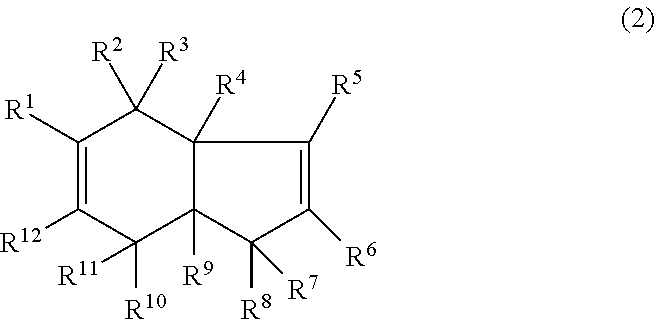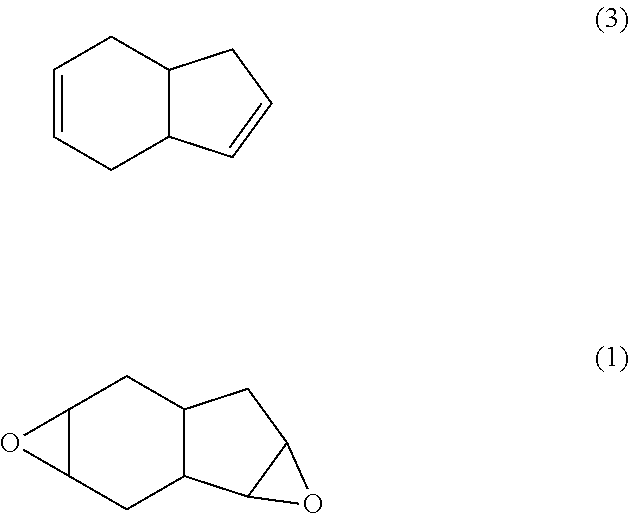Method for producing epoxy compound
a technology of epoxy compound and epoxy epoxide, which is applied in the field of method for producing epoxy compound, can solve the problems of reducing the selectivity of epoxide, troublesome post-treatment, and concern for halogen impurities in the products and environmental load, and achieves stable product quality, high reaction rate and yield, and easy isolation and recovery
- Summary
- Abstract
- Description
- Claims
- Application Information
AI Technical Summary
Benefits of technology
Problems solved by technology
Method used
Image
Examples
example 1
[0074]Into a screw-top test tube were weighed out 0.50 g of apatite that is a solid catalyst support and 0.085 g (0.015 mmol) of (Cety1Py)9(NH4)[H2W12O42] that is a solid catalyst, followed by well-mixing. To the mixture were added 0.60 g (5.0 mmol) of tetrahydroindene and 0.87 g (9.0 mmol) of a 35% hydrogen peroxide. After the mixture was stirred at 20° C. for 6 hours, the resulting reaction mixture was extracted with toluene (1 mL×3 times). The solvent was distilled out from the extracted solution thereby producing a crude product. The crude product was fed into a distillation still and distilled at a pressure of 2 mmHg thereby producing 0.43 g of tetrahydroindene diepoxide as a fraction at a column top temperature of 90° C. The yield of the product (diepoxide yield) was 57%. As the residue resulting from the extraction, 0.56 g of a solid catalyst support and solid catalyst mixture was produced.
[0075](Cety1Py)9(NH4) [H2W12O42] that is a solid catalyst was weighed out in an amount ...
example 2
[0076]Into a screw-top test tube were weighed out 0.50 g of apatite that is a solid catalyst support and 0.085 g (0.015 mmol) of (Cety1Py)9(NH4)[H2W12O42] that is a solid catalyst, followed by well-mixing. To the mixture were added 0.60 g (5.0 mmol) of tetrahydroindene, 0.31 g of toluene and 0.87 g (9.0 mmol) of a 35% hydrogen peroxide. After the mixture was stirred at 20° C. for 6 hours, the resulting reaction mixture was extracted with toluene (1 mL×3 times). The solvent was distilled out from the extracted solution thereby producing a crude product. The crude product was fed into a distillation still and distilled at a pressure of 2 mmHg thereby producing 0.40 g of tetrahydroindene diepoxide as a fraction at a column top temperature of 90° C. The yield of the product (diepoxide yield) was 53%. As the residue resulting from the extraction, 0.56 g of a solid catalyst support and solid catalyst mixture was produced.
[0077](Cety1Py)9(NH4)[H2W12O42] that is a solid catalyst was weighed...
PUM
| Property | Measurement | Unit |
|---|---|---|
| particle size | aaaaa | aaaaa |
| reaction temperature | aaaaa | aaaaa |
| reaction temperature | aaaaa | aaaaa |
Abstract
Description
Claims
Application Information
 Login to View More
Login to View More - R&D
- Intellectual Property
- Life Sciences
- Materials
- Tech Scout
- Unparalleled Data Quality
- Higher Quality Content
- 60% Fewer Hallucinations
Browse by: Latest US Patents, China's latest patents, Technical Efficacy Thesaurus, Application Domain, Technology Topic, Popular Technical Reports.
© 2025 PatSnap. All rights reserved.Legal|Privacy policy|Modern Slavery Act Transparency Statement|Sitemap|About US| Contact US: help@patsnap.com



